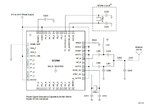robismyname
Full Member level 6

- Joined
- Jan 17, 2008
- Messages
- 390
- Helped
- 11
- Reputation
- 22
- Reaction score
- 9
- Trophy points
- 1,298
- Location
- Central Florida
- Activity points
- 4,603
I have a test board that has a TI reference design for a Lattice type balun (see attached). The lattice balun on one side is assumed to be matched to the cc2540 at 70 +30j (obtained from TI's spec sheet). And the other side of the lattice balun is assumed to be matched to 50 ohms (obtained from TI's spec sheet).
What I want to do is measure the impedance of the TI referenced design lattice balun on the differential side for now but the problem is that my VNA does not support differential inputs.
Since my VNA does not support differential inputs I need to make a coaxial balun that allows me to connect the differential side of the TI reference design lattice balun that exist on my test board.
So my questions are:
1) How do I design a coaxial balun for 2.4GHz applications? Any notes, application notes, white papers, links, calculators available that are good resources that can help me with this design?
2) Will the coaxial balun convert from differential to single ended without changing the assumed differential impedance of 70+30j? Or will the coaxial balun change my impedance on the differential side from 70+30j to 50 ohms?
3) Is it feasible/possible to connect my TI reference design test board that has the Lattice type balun on it to my vna through the coax balun without changing the assumed impedance of 70+30j?
4) Is my approach ok?
What I want to do is measure the impedance of the TI referenced design lattice balun on the differential side for now but the problem is that my VNA does not support differential inputs.
Since my VNA does not support differential inputs I need to make a coaxial balun that allows me to connect the differential side of the TI reference design lattice balun that exist on my test board.
So my questions are:
1) How do I design a coaxial balun for 2.4GHz applications? Any notes, application notes, white papers, links, calculators available that are good resources that can help me with this design?
2) Will the coaxial balun convert from differential to single ended without changing the assumed differential impedance of 70+30j? Or will the coaxial balun change my impedance on the differential side from 70+30j to 50 ohms?
3) Is it feasible/possible to connect my TI reference design test board that has the Lattice type balun on it to my vna through the coax balun without changing the assumed impedance of 70+30j?
4) Is my approach ok?
Attachments
Last edited:



